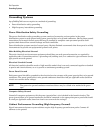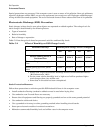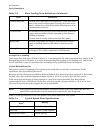
Appendix C
Site Preparation
Environmental Elements
114
Special precautions are necessary if the computer room is near a source of air pollution. Some air pollutants,
especially hydrogen sulfide (H2S), are not only unpleasant but corrosive as well. Hydrogen sulfide damages
wiring and delicate sound equipment. The use of activated charcoal filters reduces this form of air pollution.
Electrostatic Discharge (ESD) Prevention
Static charges (voltage levels) occur when objects are separated or rubbed together. The voltage level of a
static charge is determined by the following factors:
• Types of materials
•Relative humidity
• Rate of change or separation
Table C-2 lists charge levels based on personnel activities and humidity levels.
Static Protection Measures
Follow these precautions to minimize possible ESD-induced failures in the computer room:
• Install conductive flooring (conductive adhesive must be used when laying tiles).
• Use conductive wax if waxed floors are necessary.
• Ensure that all equipment and flooring are properly grounded and are at the same ground potential.
• Use conductive tables and chairs.
• Use a grounded wrist strap (or other grounding method) when handling circuit boards.
• Store spare electronic modules in antistatic containers.
• Maintain recommended humidity level and airflow rates in the computer room.
Table C-2 Effect of Humidity on ESD Charge Levels
Personnel Activity
a
a. Source: B.A. Unger, Electrostatic Discharge Failures of Semiconductor Devices
(Bell Laboratories, 1981)
Humidity
b
and Charge Levels (voltages)
c
b. For the same relative humidity level, a high rate of airflow produces higher
static charges than a low airflow rate.
c. Some data in this table has been extrapolated.
26% 32% 40% 50%
Person walking across a
linoleum floor
6,150 V 5,750 V 4,625 V 3,700 V
Person walking across a carpeted
floor
18,450 V 17,250 V 13,875 V 11,100 V
Person getting up from a plastic
chair
24,600 V 23,000 V 18,500 V 14,800 V


















